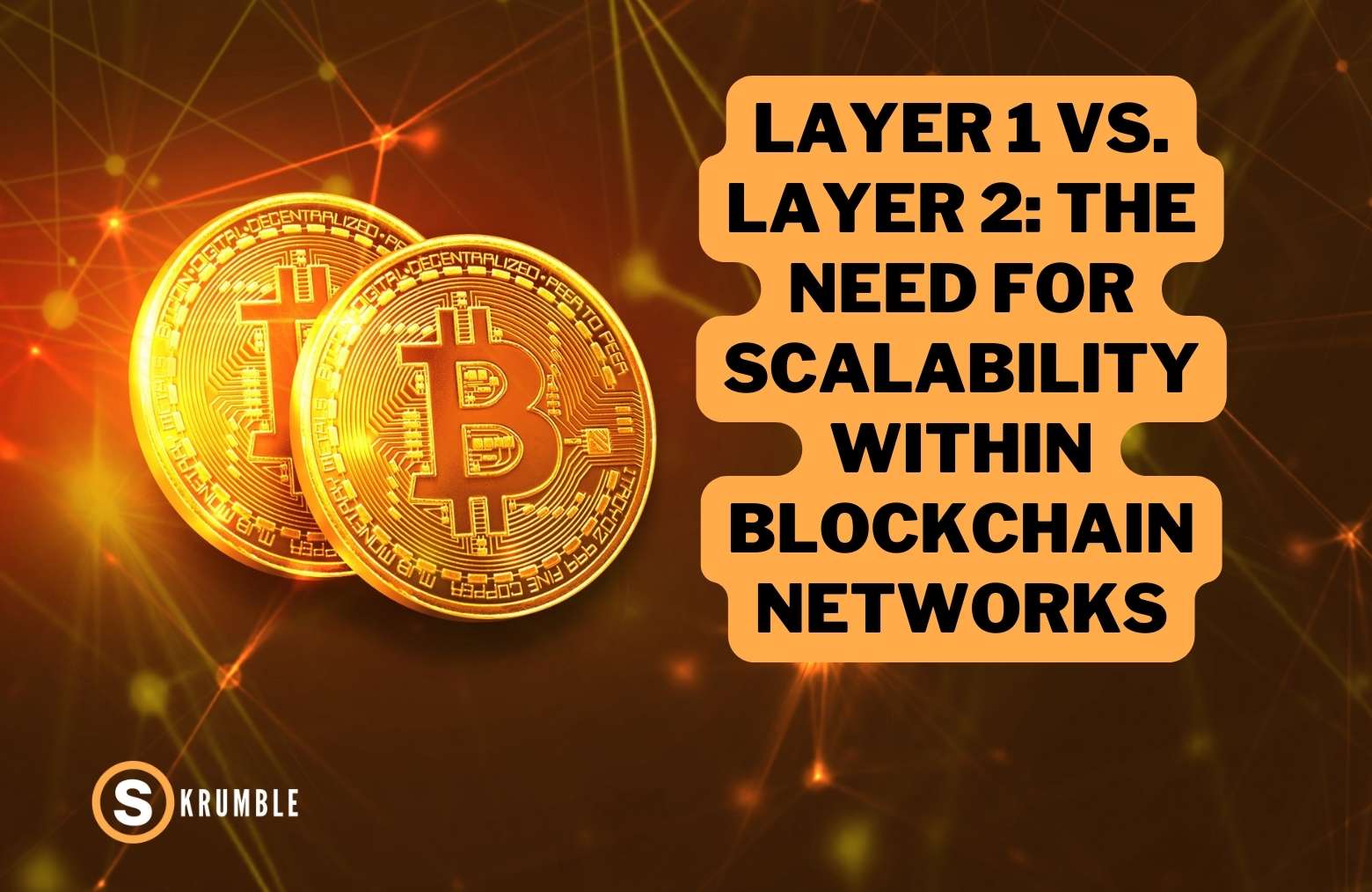- Home
- /
- Guides
- /
- Intermediate
- /
- What is Scalability in...
What is Scalability in Blockchain?
Swen Keller

Scalability in the context of blockchain refers to the ability of a blockchain network to handle a growing number of users and data without experiencing significant performance degradation. In simpler terms, it is the measure of a blockchain network’s capability to scale up seamlessly as demand increases.
Our practical experience with blockchain networks has shown us that blockchain scalability is a crucial factor for the widespread adoption and success of blockchain technologies. Achieving scalability ensures that a blockchain network remains robust and responsive and can accommodate an increasing number of participants and activities.
This article aims to provide a comprehensive understanding of the scalability problem in the context of blockchain technology. Through this exploration, readers will gain insights into the current state of the blockchain scalability problem, the hurdles it faces, and the innovative solutions paving the way for the future of scalable blockchain networks.
What is Blockchain Scalability?
In the realm of blockchain technology, scalability is a term that describes the system’s ability to handle an increasing workload while maintaining or improving its overall performance. Blockchain scalability is multifaceted, encompassing the network’s capacity to process more transactions, accommodate a larger user base, and adapt to evolving technological demands.

At its core, scalability is about ensuring that a blockchain network remains efficient, responsive, and economically viable as it scales up. In the case of decentralized systems, such as a blockchain network, scalability is a critical factor for achieving widespread adoption and ensuring the sustained success of the technology.
The concept of scalability is intricately linked with the Blockchain Trilemma, a term coined to represent the delicate balance between three key attributes: decentralization, security, and scalability. According to this blockchain scalability trilemma, it’s challenging for a blockchain system to maximize all three components simultaneously. As scalability improves, achieving a high level of decentralization and security becomes more complex, and vice versa.
This inherent trade-off poses a significant challenge for blockchain architects and developers. Striking the right balance is, therefore, essential to creating a blockchain that is both scalable and capable of maintaining its decentralized and secure nature.
The current landscape of scalability in the blockchain industry is a dynamic combo of innovations, challenges, and ongoing research. As blockchain technology gains traction across various sectors, the demand for scalable solutions has intensified. Many blockchain projects employ diverse strategies to tackle scalability issues. From optimizing consensus algorithms to introducing parallel processing, the industry witnesses a proliferation of approaches aimed at improving transaction throughput and reducing latency.
However, the journey towards achieving a scalable, secure, and decentralized blockchain ecosystem is ongoing, with continuous innovation and collaboration shaping the future of blockchain technology. Currently, there is no single “silver bullet” solution to the scalability challenge.
The Importance of Scalability and Advantages of a Scalable Blockchain Network

Scalability is not just a technical concern but a fundamental necessity for the widespread adoption and success of blockchain technology. Just as the internet’s scalability enabled its explosive growth and transformation of various industries, a scalable blockchain will help unlock its full potential and revolutionize numerous sectors.
Highly Efficient Platform
Scalability is crucial for creating a truly efficient and usable blockchain platform. Imagine a network clogged with transactions, leading to slow transaction processing times and high fees. This would deter users and hinder the development of innovative blockchain-based applications. A scalable blockchain, however, can handle a large volume of transactions efficiently, ensuring fast transaction throughput and low costs. This fosters a more user-friendly experience and paves the way for widespread adoption.
Faster Adoption
Without scalability, blockchain technology will remain confined to a small niche market with limited real-world applications. However, a scalable blockchain has the potential to attract a broader user base and facilitate the growth of the entire ecosystem. By removing the bottlenecks of transaction speed and cost, a scalable network opens doors to a wider range of use cases, from micropayments and decentralized finance to supply chain management and voting systems. This increased adoption can further stimulate innovation and development within the blockchain space.
Minimal Fees
High fees to process transactions can be a significant barrier to entry for many users. Scalability contributes to low transaction fees, a feature that holds immense appeal for users and businesses alike. As a blockchain network scales efficiently, transaction fees can be kept at a minimum, making the platform economically viable for a broad spectrum of use cases. This affordability is crucial for encouraging widespread adoption and ensuring that blockchain technology remains accessible to diverse industries and demographics.
Improved User Experience
A scalable blockchain translates to an improved user experience. Users benefit from faster transaction speed, reduced waiting periods, and more seamless interaction with decentralized applications (DApps) and smart contracts. This enhanced user experience not only attracts more participants but also contributes to user retention, as individuals are more likely to engage with a platform that offers a smooth and responsive experience.
Diverse Use Cases
The importance of scalability extends to facilitating diverse use cases for blockchain technology. Scalable blockchain networks can support a broad range of applications, from financial transactions and supply chain management to healthcare and beyond. The versatility provided by scalability expands the potential applications of blockchain, making it a viable solution for addressing challenges across various industries.
Energy Efficient
Scalable solutions can contribute to increased energy efficiency within the blockchain ecosystem. Certain scaling techniques, such as sharding, distribute the workload across a network of nodes, reducing the energy consumption per node and contributing to a more sustainable and environmentally friendly blockchain future.
Blockchain Scalability Challenges

Having gone through the several advantages scalable blockchain networks provide, now let’s explore the various problems we face as a result of this lack of scalability in the current decentralized platforms.
Based on our first-hand observations of the blockchain ecosystems, the most common challenges are:
1. Technical Limitations
Traditional consensus mechanisms, such as Proof-of-Work (PoW) and Proof-of-Stake (PoS), while effective in ensuring security and decentralization, often face scalability issues. These mechanisms involve a network-wide agreement on the validity of transactions, which can lead to bottlenecks as the number of transactions increases. Innovations in consensus algorithms, like the exploration of delegated consensus and Practical Byzantine Fault Tolerance (PBFT), aim to address these challenges and improve overall scalability.
The size of blocks in a blockchain plays a crucial role in determining the network’s scalability. Smaller block sizes limit the number of transactions that can be included in each block, potentially causing network congestion during periods of high demand. On the other hand, increasing block sizes presents its own challenges, including longer propagation times and potential centralization risks. Striking the right balance in block size, hence, is a critical consideration in overcoming scalability challenges.
Moreover, as the blockchain grows, so do the storage requirements for maintaining a complete and secure ledger. The decentralized nature of blockchain, where every node stores a copy of the entire transaction history, can lead to significant storage demands. This poses scalability challenges, especially for nodes with limited resources. Solutions like pruning, where older and less relevant data is removed, are being explored to mitigate storage challenges without compromising the integrity of the blockchain.
2. Economic Considerations
Blockchain scalability challenges extend beyond technical limitations, encompassing economic considerations that influence the viability and sustainability of scalable solutions. One of the primary economic challenges associated with blockchain scalability is the potential for high transaction fees. As demand increases and networks become congested, users may face elevated fees to prioritize their transactions for inclusion in the next block. This situation not only impacts individual users but also poses a barrier to the widespread adoption of blockchain technology for microtransactions and everyday use.
The energy consumption of blockchain networks, particularly those utilizing energy-intensive consensus mechanisms like Proof-of-Work (PoW), raises economic and environmental concerns. As scalability solutions are explored, there is a growing emphasis on adopting more energy-efficient consensus mechanisms. Transitioning to consensus models with lower energy consumption, therefore, is crucial to mitigate the economic and ecological impact of blockchain scalability.
3. Security and Decentralization Trade-offs
As mentioned before, when we discussed the blockchain trilemma, the pursuit of scalability in blockchain networks introduces a delicate balance between maintaining robust security measures and upholding the decentralized nature of the technology. These trade-offs present complex challenges that necessitate careful consideration in the development and evolution of scalable blockchain solutions.
Some scaling techniques, particularly those involving off-chain solutions or layer-2 protocols, introduce additional attack vectors that malicious actors could exploit. This increases the complexity of maintaining network security and necessitates robust security measures to mitigate potential vulnerabilities. Meanwhile, other scaling solutions rely on centralized components or validators, which can introduce single points of failure and increase the risk of censorship or manipulation. This undermines the trust and security inherent in a fully decentralized blockchain network.
Decentralization is a foundational principle of many blockchain networks, ensuring that no single entity has undue control over the network. However, achieving and maintaining decentralization becomes more challenging as scalability measures are implemented. Some solutions, such as increasing block sizes or using off-chain scaling methods, may inadvertently lead to centralization by requiring more resources or relying on specific nodes or validators. Balancing the need for scalability with the preservation of decentralization, hence, is a persistent challenge in the blockchain space.
On-chain Blockchain Scalability Solutions

On-chain blockchain scalability solutions aim to improve the scalability of the primary blockchain network itself by modifying its core architecture and protocols. These solutions directly address the limitations of the base layer and focus on enhancing transaction throughput, reducing latency, and optimizing storage requirements.
One of the most straightforward on-chain scaling solutions involves increasing the block size — allowing each block to accommodate a higher transaction throughput. While seemingly simple, this approach has sparked debates within the blockchain community. Advocates argue that larger blocks lead to increased throughput, reducing transaction congestion and fees. However, critics express concerns about the potential centralization effects, longer propagation times, and the impact on network nodes with limited resources.
Sharding is a more sophisticated on-chain scaling solution that involves dividing the blockchain into smaller, more manageable parts called shards. Each shard processes its transactions, enabling parallel processing and significantly increasing the network’s overall throughput. Sharding has the potential to enhance scalability by distributing the workload among multiple shards, but its implementation requires careful consideration to ensure data consistency, security, and coordination among shards.
Segregated Witness, often abbreviated as SegWit, is a protocol upgrade that separates transaction signature data from transaction data. By doing so, SegWit reduces the amount of data that needs to be validated by each node, effectively increasing the transaction data storage within a block. This on-chain scaling solution has been adopted by several blockchain networks, most notably the Bitcoin blockchain network, to address scalability challenges and improve transaction throughput.
These on-chain blockchain scalability solutions demonstrate diverse approaches to enhancing the scalability of blockchain networks. Each method comes with its own set of advantages and challenges, and the choice of a particular solution often depends on the specific requirements and goals of the blockchain platform. As the industry continues to evolve, on-chain scaling solutions remain a focal point of research and development, contributing to the ongoing efforts to create scalable and efficient blockchain ecosystems.
Off-chain Blockchain Scalability Solutions

Off-chain blockchain scalability solutions move some of the transaction processing workloads off the main blockchain to separate layers or networks. This approach aims to bypass the limitations of the base chain, significantly increasing transaction throughput and reducing latency without compromising security or decentralization.
Payment channels are one of the earliest and most widely adopted off-chain scaling solutions. These channels allow participants to conduct a series of transactions off the main blockchain, only settling the final state on the blockchain when necessary. Examples include the Lightning Network for the Bitcoin blockchain network and the Raiden Network for Ethereum. By minimizing on-chain interactions, payment channels enable fast and cost-effective transactions while alleviating network congestion on the main blockchain network.
State channels take the concept of payment channels a step further by enabling a broader range of off-chain interactions, including smart contract protocols. Participants can engage in multiple transactions and execute complex agreements off the main blockchain, with only the final state recorded on the blockchain. State channels offer blockchain scalability improvements for various decentralized applications (DApps) and are particularly beneficial for use cases involving frequent and rapid interactions.
Plasma is a framework for creating scalable and secure decentralized applications that operate on top of the Ethereum blockchain. By creating hierarchical structures of sidechains, known as Plasma chains or child chains, transactions are processed independently of the main Ethereum chain. Plasma provides a scalable solution for applications, games, and decentralized exchanges, allowing them to operate efficiently without burdening the primary Ethereum network with every transaction.
Off-chain scaling solutions offer significant potential for improving blockchain scalability and enabling a wider range of applications. However, addressing the inherent security and decentralization concerns remains crucial for long-term success of any blockchain network. Combining off-chain solutions with on-chain improvements and a focus on interoperability will likely be necessary to achieve optimal blockchain scalability and unlock the full potential of any blockchain network.
Layer-2 Solutions for Blockchain Scalability Issues

Layer-2 solutions are a subset of off-chain solutions that operate on top of the main blockchain, leveraging its security and consensus mechanisms while providing greater blockchain scalability and flexibility. They act as intermediary layers, handling high-volume transactions off-chain while relying on the main chain for final settlement and security.
Sidechains are independent blockchains connected to the main blockchain network, allowing users to transfer assets between the two chains seamlessly. By offloading certain transactions to sidechains, the main blockchain is relieved of congestion, leading to improved blockchain scalability. Sidechains offer flexibility and customization, enabling developers to tailor specific sidechains for particular use cases while maintaining a connection to the primary blockchain for security and asset transfer. For instance, a sidechain built on top of a PoS blockchain may have a different consensus mechanism, such as PoH (Proof-of-History) or dPoS (Delegated Proof-of-Stake), but still be connected to the main chain.
Roll-ups are layer-2 solutions that optimize on-chain transactions by bundling them into a single “roll-up” and submitting it to the main blockchain. This approach significantly reduces the number of individual transactions processed on the main chain, resulting in improved efficiency and lower fees. There are two main types of roll-ups: optimistic roll-ups, which prioritize efficiency but require a dispute period for potential fraud, and zk-roll-ups, which leverage zero-knowledge proofs to ensure transaction validity without the need for a dispute period.

Conclusion
The quest for efficient and secure blockchain scalability is an ongoing journey. While no single solution currently offers a perfect balance between blockchain scalability, security, and decentralization, ongoing research and development are continuously pushing the boundaries of what’s possible. Emerging consensus mechanisms, interoperability solutions, and advancements in cryptography may further revolutionize how blockchain networks scale, ensuring they remain adaptable to the evolving needs of users and industries.
Achieving true blockchain scalability is crucial for unlocking the full potential of this transformative technology. By overcoming existing challenges and embracing innovative solutions, we can pave the way for a future where blockchain empowers a vast array of applications and revolutionizes various sectors. As the community continues to explore new avenues and collaborate on solutions, the future of blockchain scalability holds immense promise for a more efficient, secure, and interconnected world.
FAQ
Most frequent questions and answers
In the crypto industry, scaling refers to the ability of the blockchain network to handle a growing volume and number of transactions and users without compromising on efficiency and performance.
Solana is widely believed to be the most scalable mainstream blockchain. The Solana development team claims that the Solana network is capable of reaching a speed of over 50,000 TPS. Other highly scalable blockchains include Plasma, Polygon, Polkadot, and BNB Smart Chain.
Private blockchains are relatively more scalable, as these chains have a limited number of users and centralized governing models.
The most commonly used metric is TPS, which represents the number of transactions a blockchain is able to complete in one second. High TPS signifies better blockchain scalability.
Skrumble.com provides all its content for informational purposes only, and this should not be taken as financial advice to buy, trade, or sell any investment instruments or products, including but not limited to cryptocurrencies, or use any specific exchange. Please do not use this website as investment advice, financial advice, or legal advice, and each individual’s needs may vary from that of the author. Investing in financial instruments, including cryptocurrencies, carries a high risk and is not suitable for all investors. It is possible to lose the entire initial investment, so do not invest what you cannot afford to lose. We strongly advise conducting your own research before making any investment decisions. This post includes affiliate links with our partners who may compensate us.
To view our privacy policy read here.






